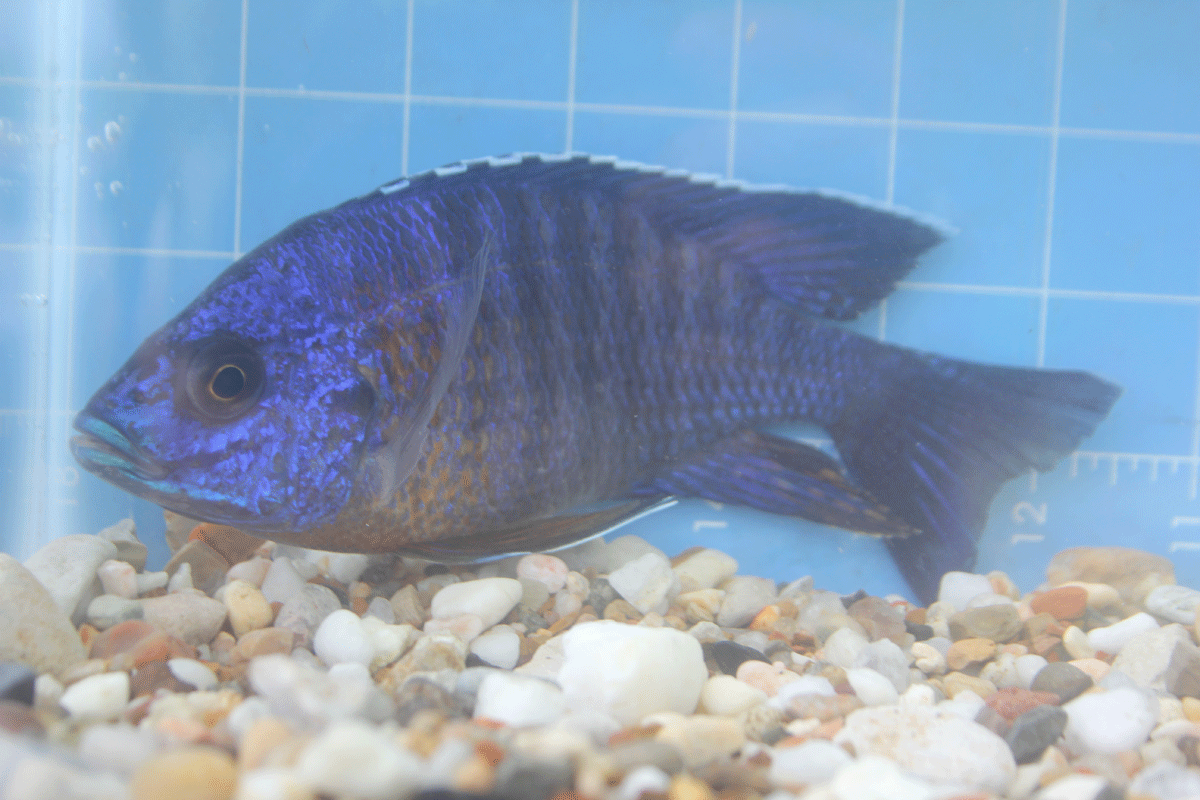Photo of a male Aulonocara stuartgranti ‘Chiloelo’ we are currently selling.
We raise a number of species in the Aulonocara genus, including these populations of Aulonocara stuartgranti: Chiloelo, Flavescent, Maulana Bi-Color, and Mbenji Blue Regal. This blog concerns Aulonocara stuartgranti ‘Chiloelo.’
We acquired the Chiloelo population of A. stuartgranti in July 2012 from Fish Gallery – Houston, a longtime wholesale customer (see https://www.thefishgallery.com/pages/locations-houston). Chiloelo, like other Aulonocara species (except for A. jacobfreibergi, Undu Reef, the Lemon Jake, which I find difficult and will blog about sometime in the far, far future in a parallel universe far, far away) is a prolific breeder.
Our current breeding colony, set up just days before Hurricane Harvey tried to kill all our fish, consists of two males and 44 females in a 300-gallon vat. The male pictured above is a surplus breeder and will be sold along with four females on Aquabid.com. Unlike some of our other fish, Chiloelo seems to have come through Hurricane Harvey and its aftermath with few to no casualties.
We raise A. stuartgranti ‘Chiloelo’ like we raise other maternal mouthbrooders. Breeders are set up in 300-gallon vats and allowed to breed naturally. We used to place six males in each vat, but have found that the females survive a lot better with fewer males. With six males, the females don’t have much space to avoid the males when they are carrying eggs. The risk of using only one male is the possibility of losing an entire breeding cycle if the male dies. Two males seem to be a good compromise. Interestingly enough, the two males tend to stay near each other. The females stay away from the males most of the time. Presumably they approach the males to breed since they end up carrying eggs.
The male in the photo above is about 18 months old and will live another seven to eight years with good care. The one-inch grid behind him shows his present size, just over six inches in total length. He has done most of his growing and will gain length only slightly. We’re offering him on Aquabid.com with four females (more females are available and, as usual, other fish from our site can be added).
Each vat is equipped with six cichlid hotels and two fry cages. Why six hotels? So that we know how many to remove when processing and harvesting the fish. The cichlid hotels provide refuge for the females and young fish. The fry cages are oases for fry. Each cage has two cichlid hotels in it. About two months after setting up the colony, we lift the cages and dump any fish out. This allows smaller fish to go back in (the mesh is half inch) to avoid their older brethren, which can be two inches long at this point. At about three months, we harvest the vat.
Harvesting consists of removing the cichlid hotels and cages and netting the fish out. The fish are sorted into 1-2”, 2-3” and 3-4” offspring and breeder adults. There are usually five 55-gallon vats associated with the 300-gallon breeding vat. One each for 1-2”, 2-3”, 3-4”, adult female, and adult male fish. These fish vats are our sale vats. We don’t sell 3-4” Peacock cichlids and this vat holds future adult sale fish and potential replacement breeders. These five vats are netted out and the fish assorted into the proper vat by size and sex. The fish from the 300-gallon vat are also sorted and placed into the proper vat. Any breeder losses are made up from the previous 3-4” vat and the breeding vat is set up anew. We place one to three large plecostomus (Hypostomus plecostomus) in the breeding vat to control algae and snails and to stir up the bottom to prevent buildup of mulm (detritus).
And the cycle starts again…
Good fishkeeping!


Leave a Reply